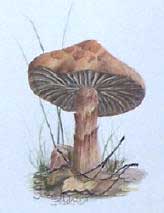 |
 |
|
Gouache paint is often called 'Designers Gouache' due to it's opaqueness, speed of drying and matt finish, being so necessary for designer, illustrators and commercial artists. Gouache - pronounced gwash as in squash. If you wish to know more about the different ways of pronouncing 'the word' Gouache click the link. |
|
A good quality Gouache paint is a mix of pigment and Gum Arabic. Gum Arabic is the binder for the pigment, giving it a creamy 'flow' consistency, cheaper varieties may have chalk added to the pigment and they often 'flow' less than a better quality product. Gouache can be used thin to give a wash at the start of a painting allowing the thicker layers to be used towards the end. |
A star or letter rating gives the permanency of the colours. I would suggest for fine art use 'extremely permanent' and 'permanent' colours. |
| Gouache is a quick, direct and amenable medium, with superb covering power. You don't need to reserve your 'white' as in watercolour; it's more controllable then watercolour and you can remove mistakes and re-paint. Sable or Synthetic brushes are ideal, bristle brushes if you want more expressive brush marks |
|
| Gouache painting techniques are usually used on watercolour paper, white or tinted. You can also use coloured pastel paper or mount board. I would recommend heavier papers to give a more stable surface for the paint, especially if you like to paint in numerous layers. They are also best preserved under glass using a mount. |
|
| Gouache paint is designed to be applied fairly thickly; diluted with too much water and they can 'powder off'; applied in too many thick layers and they have a tendency to crack. The cracking is due to the under layers, absorbing the water and Gum Arabic out of the newly applied paint, but it only become apparent when dry. 'Less layers are best layers' with Gouache! I especially like them for small and detailed paintings, give them a try, they can be very rewarding. |
|

|
|
Home - About Me - Blending Coloured Pencils - Dip Pens - Galleries - Gallery of Flowers - Gouache - Ink Properties - Links -
News - One-Stroke Brushes - Painting Techniques - Pen and Ink - Testimonials
|
|
|
Copyright © 1999 Jacqui Blackman This is the Copyright and Intellectual Property of Jacqui Blackman |
|